Polarizers (and Infrared)
2005 legacy content
What is a polarizer?It is a photographic filter that usually is screwed in front of your lens.
What does it do?
It removes reflections from non metallic-conductive materials like glass, water, paint. These reflections are often unwanted. Furthermore, it cuts through haze and makes a blue sky even bluer.
How does it work?
Well, it is probably the photographic filter most difficult to understand. To explain it, imagine light as being sent to us as waves. Not a single wave but many. They have different wave-lengths (colours), different orientations and different intensities.
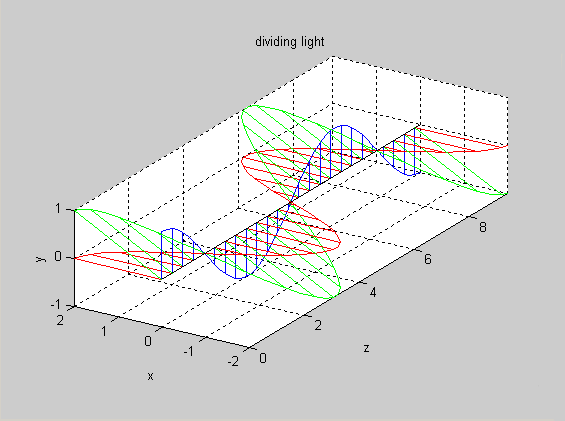
Let's look at a multitude of waves, namely unpolarized light with different wavelengths:
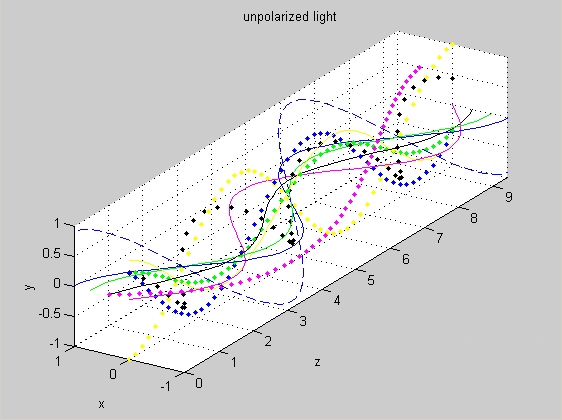
For the sake of clarity, we will now look at only one wave. I don't want (nor could I) give a physics lecture but I have to mention the brewster angle. To explain it, let's first have a look at what happens if a light ray (a bundle of waves) hits a surface:
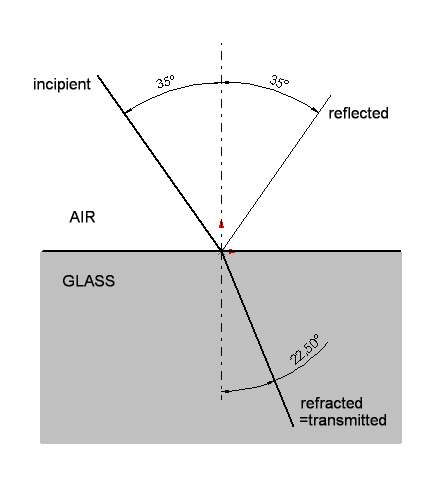
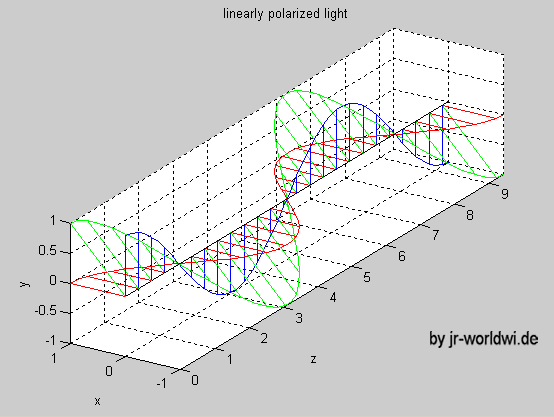
If we want to remove this light, we use a polarizing filter. It lets only light pass that oscillates in a certain plane. This means the polarizer will swallow all light oscillating in other planes. Usually that's about 1 to 2 stops, meaning your exposure time gets two to four times longer, if you stay at the same aperture! To understand its effect, I always imagine a comb. Everything that is parallel to the "teeth" of the comb will pass, everything 90° to them will not pass at all and everything in between will partially pass.
So, what is a linear and what is a circular polarizer?
The linear polarizer is simply the above-mentioned comb. However, some cameras will not work with them. The reason is that these cameras have reflecting optical elements like mirrors in SLR-cameras. I already tried to explain how reflecting surfaces influence the polarisation of light. If the light is already polarized, the reflected light is unsuitable for the camera to use for autofocus and metering. Luckily, there is one solution. A circular polarizer. It makes the linearly polarized light circularly polarized:

How does it do that? It has a second layer of optically active material. This material is very special. In one direction the speed of light is higher than in the one 90° to it. This is called birefringence. The effect is that the blue or red part of the green linearly polarized wave from the "linearly polarized light" graphic gets slowed down in this layer. It gets shifted backwards by a quarter of a wave length. Therefore this special layer is called a quarter wavelength plate or a quarter lambda plate or quarter wave plate (QWP). Now, in the picture above, the blue wave stays unmodified, while the red one was slowed down. Recombining (the opposite of deviding) these two waves yields the new green wave. But now, this wave is making a circle! It is circularly polarized. If this light hits the mirror of an SLR, it is reflected in a way that will not confuse the internal sensors of the camera.
Are these filters linear or circular different in their effectiveness?
No. But linear filters are cheaper and as they have one optical layer less than circular filters, they often have better contrast than circular polarisation filters.
Which one should I get?
A circular polarisation filter will work with every camera on the market. A linear polarisation filter will not work correctly in SLR cameras and other cameras that use mirrors or prisms. Jeremy has a simple test on his site how you can test if your camera can handle the linear polarisator:
www.dpfwiw.com/polarizer.htm#circular
If you are further interested in polarisation, check out his complete page about it.
Another good forum post is from Ching-Kuang:
forums.dpreview.com/forums/read.asp?forum=1024&message=6913931
Are there any do-it-yourself experiments?
Sure, apart from Jeremy's section about
reversed circular polarizers
that act as warming/cooling filters, there is also the possibility to examine materials with birefringent properties. Pete has put up a very nice gallery:
pbase.com/pganzel/polarizers
Obviously, birefringence is not as rare as one would believe. In fact, Pete wrote in his forum message, that a simple piece of cellophan can substitute a quarter-wave-plate. He notes correctly that you will not achieve exactly one quarter of a wavelength redardation. Obviously it is often enough for SLR to focus.
- Side note:
Often materials change the speed-of-light when compressed or extended. This results in strange effects as the light gets retarded accordingly. This was (and sometimes is still) used to examine mechanical parts exposed to loads: Optical stress analysis. You manufacture a model of the original part out of some kind of plastic (Plexiglas for example) with the property to be birefringent when under stress. When it is photographed the areas with high stress show and the design of the component can be altered to reduce the stress. To make it visible, you have to first linearly polarize the light from a light source. Between specimen and camera there is another linear polarizer, turned by 90° (total blocking) towards the first one. So, unmodified light that passes through non-birefrigent areas will not get through to the camera. But the light modified by the specimen is visible.
If you are further interested, I suggest:
www.anu.edu.au/.../OSA_01.pdf
www.mupad.de/.../maschinenbau.pdf [German]

Now, the view from the front, showing why it is called circularly polarized:
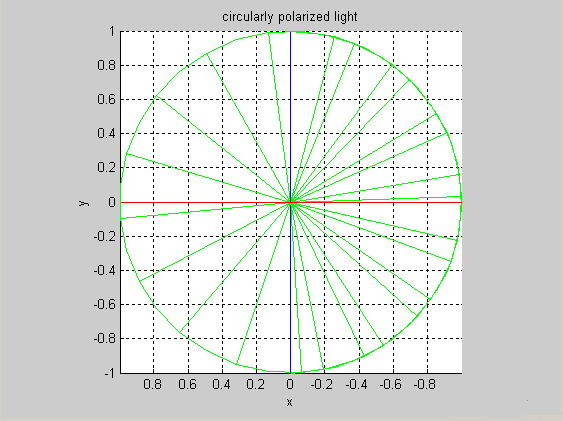
Next up, the 3D-view of two waves a fifth of a wavelength apart:
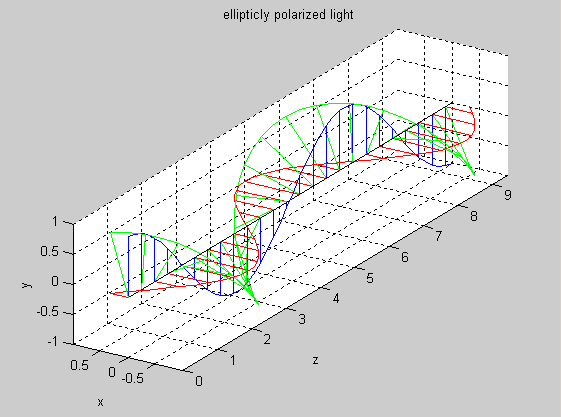
When viewed from the front, it is obvious, that the light is now ellipticly polarized:
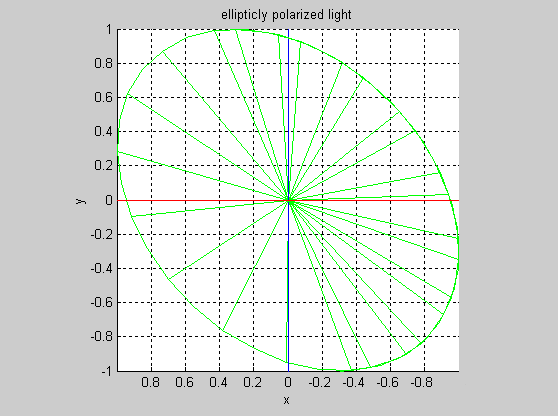
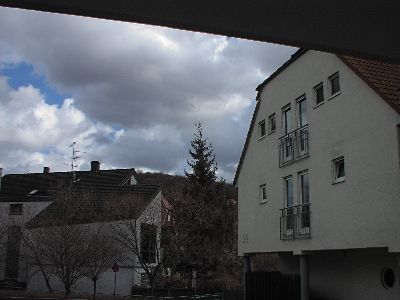 |
Camera: Olympus 2040IR Filter: none Exposure time: 1/400 F-stop: 9.0 ISO speed: 100 Focal length: 7.3000 White balance: custom aEV: 14.9837 comments: |
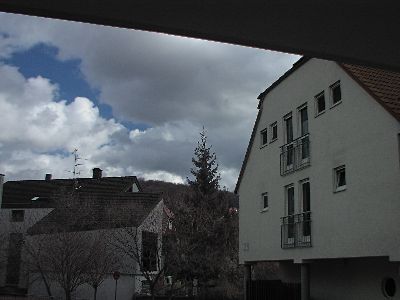 |
Camera: Olympus 2040IR Filter: one linear polarizer Exposure time: 1/800 F-stop: 4.5 ISO speed: 100 Focal length: 7.3000 White balance: custom aEV: 13.9837 comments: exactly one stop slower! |
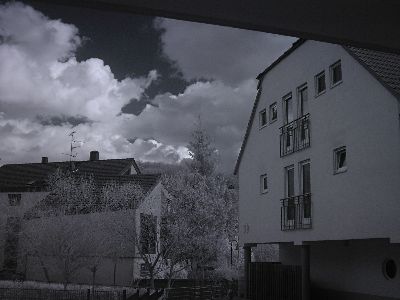 |
Camera: Olympus 2040IR Filter: two linear polarizers Exposure time: 1/250 F-stop: 1.8 ISO speed: 100 Focal length: 7.3000 White balance: custom aEV: 9.6618 comments: Hm, more than 5 stops slower, but where's the colour gone? Normally, two polarizers result in a strong blue cast. I did a white balance on the house wall (as always) and there is almost no colour in the photo. This almost looks like an infrared photograph. I know that blue light is special, because it is circularly polarized in the sky due to the water droplets, but what is happening here? |
Ok, now, let's try with my 2020, much less sensitive to IR! |
|
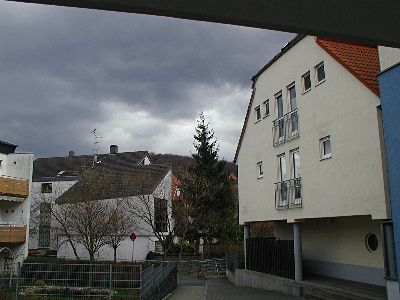 |
Camera: Olympus 2020 Filter: none Exposure time: 1/500 F-stop: 4.0 ISO speed: 100 Focal length: 6.6000 White balance: automatic aEV: 12.9658 comments: |
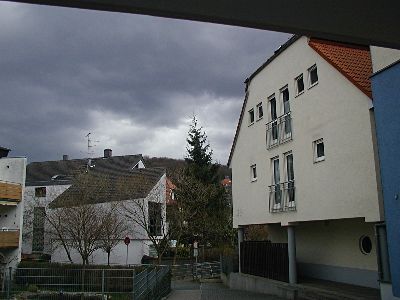 |
Camera: Olympus 2020 Filter: one linear polarizer Exposure time: 1/500 F-stop: 2.2 ISO speed: 100 Focal length: 6.6000 White balance: automatic aEV: 11.2408 comments: Hm? Suddenly much more than one stop slower! |
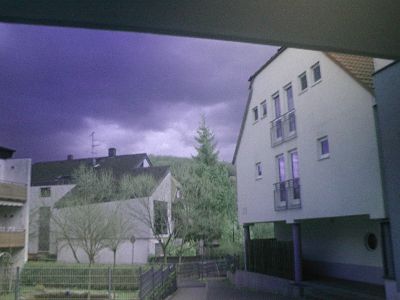 |
Camera: Olympus 2020 Filter: two linear polarizers Exposure time: 1/3 F-stop: 2.0 ISO speed: 200 Focal length: 6.6000 White balance: automatic aEV: 2.585 comments: What? 10 stops slower?? This is over a 1000 times slower! Ok, the picture is not pretty and very blurry (handheld) but still... |
Ok, the first test was shot with my full-spectrum modded 2040IR, a camera seeing all wavelengths from deep blue to near infrared. Compared to that my 2020 is nearly IR blind. This leaves two possible conclusions:
| |
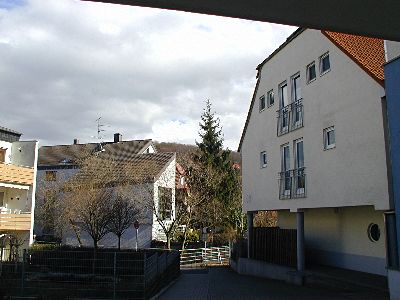 |
Camera: Olympus 2020 Filter: none Exposure time: 1/400 F-stop: 5.6 ISO speed: 100 Focal length: 6.6000 White balance: automatic aEV: 13.6147 comments: |
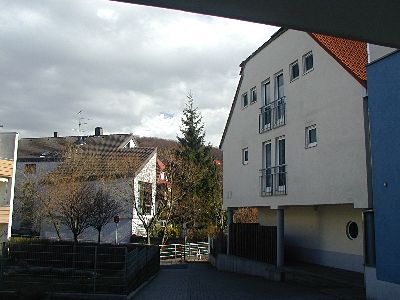 |
Camera: Olympus 2020 Filter: one linear polarizer Exposure time: 1/400 F-stop: 3.2 ISO speed: 100 Focal length: 6.6000 White balance: automatic aEV: 12.000 comments: Ok, 1.6 stops slower, obviously my second LP is darker! |
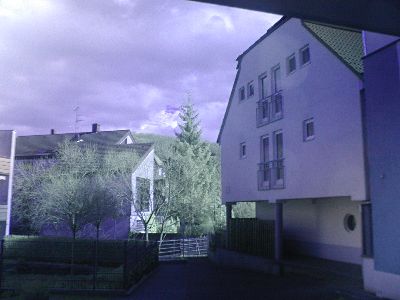 |
Camera: Olympus 2020 Filter: two linear polarizers Exposure time: 1/6 F-stop: 2.0 ISO speed: 200 Focal length: 6.6000 White balance: automatic aEV: 3.585 comments: With the two LPs set to maximum extinction, again about 10 stops slower. |
| This leaves one conclusion: My linear polarizers are only effective in visible light! For near IR light like my 2040IR can see, they let most IR pass, even if they block much visible light. One final test: Compare exposure with two LPs and secondly two LPS and IR pass filter. If I am right, the exposure difference should not be high. Let's see. | |
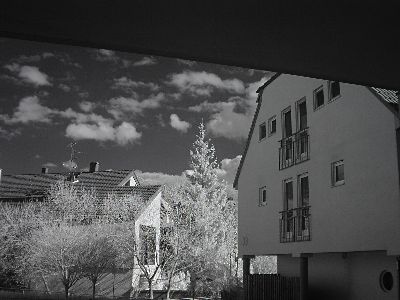 |
Camera: Olympus 2040IR Filter: two linear polarizers Exposure time: 1/200 F-stop: 1.8 ISO speed: 100 Focal length: 7.3000 White balance: custom aEV: 9.3399 comments: Very nice atmosphere |
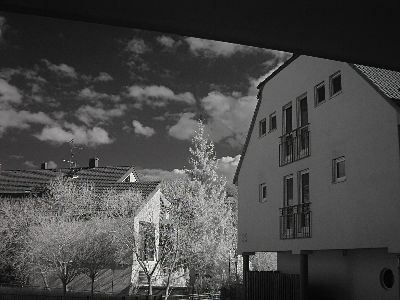 |
Camera: Olympus 2040IR Filter: two linear polarizers and Heliopan 715nm IR pass filter Exposure time: 1/200 F-stop: 1.8 ISO speed: 100 Focal length: 7.3000 White balance: custom (not changed from above) aEV: 9.3399 comments: Absolutely no difference, neither in exposure value nor in colours! |
Result: My linear polarizers let IR pass, but are very effective to remove visible light (10stops). Now, compare the exposure with a) only the IR pass filter and b) the IR pass filter and the two LPs. | |
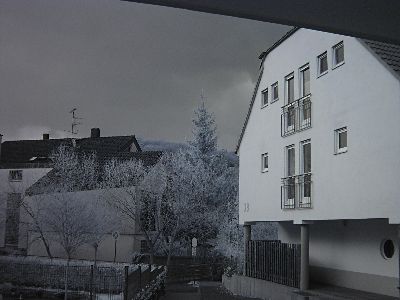 |
Camera: Olympus 2040IR Filter: Heliopan 715nm IR pass filter Exposure time: 1/250 F-stop: 1.8 ISO speed: 100 Focal length: 7.3000 White balance: custom aEV: 9.6618 comments: |
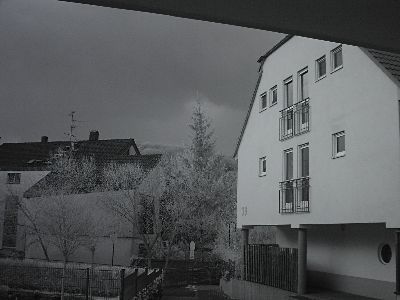 |
Camera: Olympus 2040IR Filter: two linear polarizers and Heliopan 715nm IR pass filter Exposure time: 1/30 F-stop: 1.8 ISO speed: 100 Focal length: 7.3000 White balance: custom (changed from above) aEV: 6.6029 comments: The two additional linear polarizers cause (only) a 3stop difference. In visible light on my 2020, they caused 10stops! |
|
Now, as the final picture in this series: | |
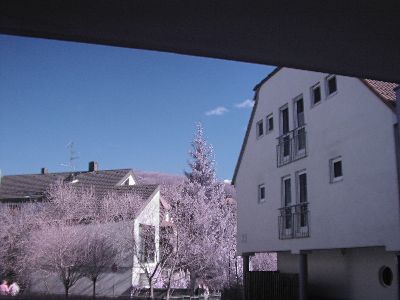 When using only the two linear polarizers, it is possible to "dial in" the amount of visible light. In the pictures above I showed that when the two LPs are set to maximum extinction, nearly only infrared light will pass. With a mild IRable camera like my 2020, this is not clearly visible. But on my 2040IR, a picture like on the left can be created. From maximum extinction, turn one LP slightly. You will see how visible light (colour!!) starts to appear. When you have set the two LPs to least effect, e.g. the teeth of the two combs are parallel, mostly visible light will be recorded. Dialing in/out visible light gives nice effects. |
|
|
Now, do polarizers work in IR? One should assume that if polarizers let IR pass, they are not effective in IR. Probably this is true to some degree, however, look at the following pictures: | |
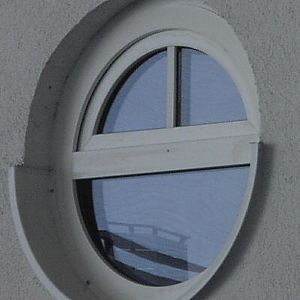 |
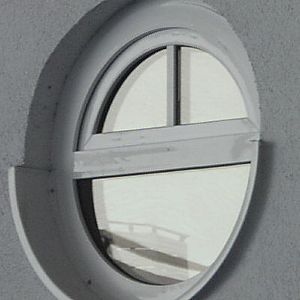 |
|
Interestingly, there is surely some effect in IR light. This was shot with my 2040IR, a 715nm Heliopan IR pass filter and a linear polarizer. Please note that for example www.edmundoptics.com offer special (scientific) polarizers for near infrared (nIR). These cost about 5 to 10 times what you would pay for normal polarizers. Still interested? Then browse their online store :)
The following pictures were taken in visible light with my 2020 to show what effect a polarizer has on a "normal" camera in visible light: | |
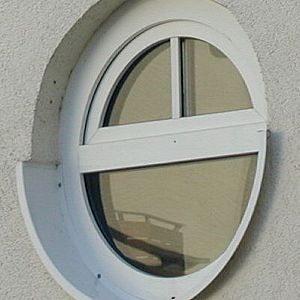 |
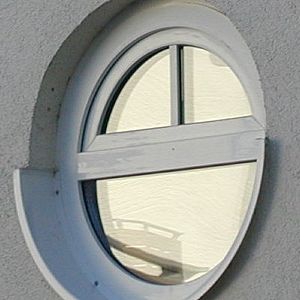 |
| About the same effect as in IR light, I would say. | |
|
Enrico found out by testing that two polarizers (lin/lin/camera or lin/circ/camera) plus a red filter enables you to do IR with unmodded cameras:  | |
Summing it up:
- two linear polarizers can be used on normal cameras to create a strong "almost neutral" variable density filter. The resulting blue cast must be removed through white balance
- on IR-enabled cameras like my 2040IR, they effectively cut out visible light but let IR pass
- to get IR with normal cameras, you need a red filter
- on my 2040 IR they are inferior to an IR pass filter, as they need longer exposure times. However, on a Sony with its nightshot modes, they could prove very handy because they lengthen the exposure time, so that the 1/30 second limit for nightshot can be reached more easily.
- when using two LPs, it is possible to "dial in" the amount of visible light on my 2040IR and probably the Sony 717, 707 and 828, too.
- using two LPs crossed at 90° removes the last bit of colour, compared to the relatively mild 715nm IR pass filter.
- polarizers will somewhat work in IR, but expect no miracles
Pete once again has a nice addition, a spectral transmissibility curve for crossed linear polarizers:
forums.dpreview.com/...
Bjørn Rørslett has some interesting pictures and info on this topic:
www.naturfotograf.com/false_IR_D1.html
Furthermore, the Sony Forum at dpreview.com is very useful:
Forum search crossed polarizers
Forum search crossed polarisers
copyright 2004...05, 2019 by jensroesner.de